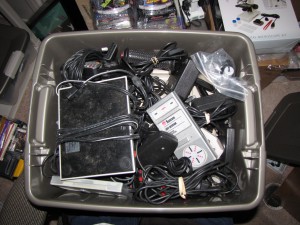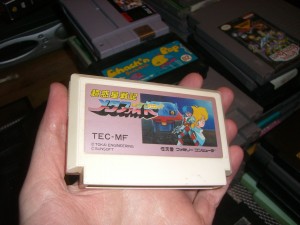Category — Video Games
Game #2: Kid Chameleon – Sega Genesis
Kid Chameleon is a bit of a cross between Super Mario Bros 3, Little Nemo: The Dream Master, and the “Moriarty takes control over the Enterprise” episodes of Star Trek: The Next Generation.
The boss of a holographic VR game has taken control of the game and is kidnapping the players. It’s up to you to enter the game and defeat the boss.
No, that doesn’t look anything like the Holodeck at all. This is orange, not yellow. No similarity whatsoever.
You play Generic Tough Punk Kid, with sunglasses, plain white tee, and blue jeans, ready to kick ass. Scattered throughout the levels are P blocks, which contain generic pick me ups, or chameleon helmets. The helmets turn you into something else, with some kind of special power that you’ll probably need to pass the level. There’s the Ninja that can jump fifty feet and has a sword, there’s the Knight that can climb walls, there’s the Thick Headed Monster that can break walls, and, of course, there’s the Axe Murderer in a Hockey Mask.
Overall, it seems like a prety decent game. I would’ve kept playing, if I hadn’t blown through a couple of continues when I got stuck in the Lava World From Hell.
November 4, 2010 No Comments
Game #1: Blaster Master 2 – Sega Genesis
Blaster Master was a classic on the NES. It was a bit like Metroid in a tank. Exploration, power-ups, amazing graphics, and catchy songs.
Its sequel, Blaster Master 2 for the Genesis is like Metroid with a tank and without any of the fun or awesomeness.  Honestly, I couldn’t bring myself to play it long enough to really understand what it is. It appears to be far more linear than its predecessor. It also stole Rygar’s sunset.
I couldn’t get the hang of the controls, and there were far too many things that wanted to shoot me or jump on me or fall on my head. There’s also inclines, which change your firing angle when you drive on them, making it very difficult to shoot what you want to shoot.
You can get out and walk around, just like in the original, however, in this one, some of the caves you end up in have large-sized side-scrolling regions. In these regions, your character Jason handles like a lobotomized monkey. You can kneel or shoot straight down, but you never do the one you want to do. Not that it matters. Shooting down shoots your feet, and kneeling shoots over the top of ground dwelling creatures. You can’t shoot at an angle, and you can’t shoot down while jumping. That means that you can’t actually shoot the space slug you meet up with early on until it stands up. And did I mention that once you’re shooting, if you stop moving, you can’t start moving until you stop shooting? That part is especially awesome in an action game where you have to both shoot and get out of the way…
Collision detection is awful, as well. Many times, I stood and fired at an enemy, then got hurt several seconds later, even though neither me nor the enemy had moved a pixel.
There’s a pause screen that I’m sure would be useful, if I understood it at all. Unfortunately, it’s not mentioned in the manual.
That’s an easy choice to make.
November 4, 2010 No Comments
Video Game Bender Weekend
Oh yeah, I forgot to mention what I’m doing…
I just finished the video game room in my house, so I’ve decided to celebrate by taking a lost weekend and going on a four day video game bender.
I have no set plan, I’m just going to play what I feel like playing, when I feel like playing it, for as long as I feel like playing it.
There will be eternal classics and there will be total crap, and I plan to post screenshots and short descriptions of whatever I play.
I’ve got a lot of different gaming consoles, and I plan to give many of them a workout over the next few days.
November 4, 2010 No Comments
First up: Sega Genesis
The Genesis came out in the early 90’s ((Okay, technically the late 80’s, but that doesn’t really count.)) and was a rival in both ability and popularity to the Super Nintendo. The standard controller has three face buttons, a start button, and a D-Pad. It did not have any shoulder buttons.
It’s also got Blast Processing. No one knows what Blast Processing is, except that it makes things totally awesome.
Genesis controllers are compatible with the Atari 2600, so if you want to play Space Invaders or Pitfall with a gamepad instead of a joystick, this is a good way to do it.
November 4, 2010 No Comments
Camera Found. Let’s Get Started.
I can’t upload directly from the camera, though. So that sucks. Anyone have a good WP plug-in for that?
November 4, 2010 No Comments
Slightly frightening.
I have a lot of bizarre joysticks and controllers for all sorts of game systems.
Thankfully, I was able to find what I was looking for.
Now, does it work…?
February 26, 2010 No Comments
The Cupcake of Glory
Each Crazy Weekend Project has a crazy goal they’re aiming for. The first was to get a perfect game in Pong. The second was to eliminate Wesley Crusher. For this one, it’s joining the Bucket Brigade.
Part of what set Activision apart, aside from making awesome games, was that for pretty much every game, you could get a patch to prove that you’d obtained some high score. Just snap a picture of your score, mail it in, and a few weeks later, you’d get three inch trophy to commemorate your achievement for free. Some games had multiple patches for different difficulty levels.
For Kaboom!, you could get the Activision Bucket Brigade patch for a score of 3000 or higher. To reach this level, you had to be good, but you didn’t have to be perfect. An ordinary player would be able to get this score, given enough practice.
My primary goal for this weekend is to build a robot capable of getting a score in Kaboom! that will qualify it to join the Bucket Brigade. I’ll then send a picture in to Activision and see what happens…
The spirit of these patches lives on in the XBox 360 and PS3. Games for those systems feature Achievements or Trophies which you get for doing something specific in the game. However, instead of having just one, games will typically have up to 50. And, unfortunately, they’re all electronic, so you can’t show them off.
February 25, 2010 No Comments
James Cameron Plays Too Many Video Games
Let’s see…Â He’s played…
Final Fantasy X:Â
Â
Suteki Na De cutscene
Â
Panzer Dragoon Orta:
Â
Episode 2: Altered Genos
Episode 4: Gigantic Fleet
Secret of Mana:
 Â
Title Sequence ((The Japanese version because it shows more of the tree.))
Â
Mana Tree Cutscene
Â
Command & Conquer:
Mechanical Man
The Orca
Â
The Legend of Zelda: Ocarina of Time
HEY! Listen!
January 3, 2010 No Comments
Tidbits
I seem to have been neglecting this lately. I’m a week overdue on a programming/testing post, and it’s almost getting to the point where I’m late on a video game history lesson. So, to prove I’m not dead, here’s a few bits of here and there.
First, if you’re in Washington, you have less than a week left to Approve Refererendum 71. I already have. Have you?
Now, back to games and things. Here’s a few of my latest acquisitions.
This one should require no introduction or explanation. Tengen Tetris. I spoke about this game several times in previous entries, alluding to the legal fight between Atari and Nintendo, but always in passing. Now that I actually have a copy, I’ll have to devote an entire article about it. That’ll be in the future, but for now, to illustrate its awesomeness: Two-Player Cooperative Mode.
The second notable acquisition is a Japanese Famicom game called Metafight. Well, it’s actually “Something-Something Metafight”, but I don’t know Japanese. The cover has some generic anime characters, one of which looks angry. None of that really matters. I’m not really into Japanese things and I’m not really into anime or stuff like that. And I don’t have a Famicom system.  So, then, you ask, why would I go out of my way to buy a Japanese anime game for the Famicom?
This screenshot might help you figure it out. It at least might look a bit familiar to you. Maybe. Can’t quite place it? This’ll do it:
Metafight is the Japanese version of Blaster Master. ((And if you don’t know what Blaster Master is, well, you just need to play more NES games.)) There is no opening story sequence in Metafight, which automatically means that the plot for Metafight makes far, far more sense than the “My pet frog jumped on a box of radioactive waste in my backyard and went down a hole and I followed it and found this bad-ass hyper-agile tank in the underworld and I proceeded to fight lots of nasty creatures in my bad-ass hyper-agile tank in order to rescue my radioactive mutant pet frog and save the world from the radioactive mutants that live under the Earth’s crust” plot that Blaster Master tried to have. Of course, since Blaster Master changed the story from whatever angry anime guy was doing to something stupid about a mutated frog, they had to change the tank ignition sequence to be in a cave, instead of Metafight’s futuristic tank garage.
But enough about that for today. It’s time for robots.
It’s been a while since I’ve visited the land of the video game playing robots, but I assure you, I have been thinking about them. I think the next time I get back into them, assuming I ever do, the first thing I’ll do is organize the codebase. It was built to get it to market, but not built for future expansion. If I want to keep going with this, I’ll need to rewrite large sections of it and separate the movement interface and screen capture plumbing from the game specific recognition and logic code. Although it won’t be quick, that should hopefully be reasonably straightforward to do. From there, I’d like to work on improving the control of the paddle. A few weeks ago, I think I may have improved the precision of the controls, but I still haven’t tested it out.
At any rate, I think Pong is the wrong game to try to develop precision controls. The trajectory projection gets in the way of making sure the paddle is moving exactly where I want it to go as fast as I can get it there. The paddle might very well be going where I want it, but by the time it gets there, that’s no longer where I want it. So, I think I’m going to have to try another game to tune the paddle controls. Right now, I’m leaning toward Kaboom! as the game of choice. It should have easy to program recognition and logic (Bomb drops straight down, move to catch bomb, repeat), and it will absolutely require precision, accuracy, and speed. Runner up is Indy 500, but I think the pathfinding and collision avoidance knock that one out at this point, not to mention the 360 degree driving paddle. An interesting side-note is that pretty much whatever paddle game I choose, I’ll have to deal with something I didn’t care about in Pong: The button.
Beyond the paddle, to really get things done on the Atari 2600, I’m going to need to be able to control a joystick. I have several options, of course. I can try some alternative controller, like the button operated Starplex or the gravity operated LeStick, but really, or maybe try to build my own controller, but really, to claim that I built a robot that can play an Atari 2600, I have to build something to handle a good old CX40 Atari Joystick. That’s probably not going to be easy. The controls won’t have to be as precise as the paddle, since there’s only nine options, however, it’s going to involve control on two axes that are somewhat dependent on one another. I’ve had thoughts involving double arms that push or pull, a swing arm with a piston, a gantry crane like setup, and something that rotates and can push the stick, and none of those ideas seem any good at all. I’m sure I’ll think of something.
October 27, 2009 1 Comment
Electric Curiosities: Pac-Man vs. K.C. Munchkin
The game is familiar. You play a round creature that lives in a maze. You’re chased by monsters and have to eat dots to survive. Some of the dots let you attack the monsters temporarily. When you get all the dots, the maze resets at a higher speed. It’s a lot like Pac-Man, but it isn’t. The game is K.C. Munchkin, and you’ve probably never heard of it, let alone played it.
If you have heard of K.C. Munchkin, then it’s probably because of the lawsuit.
Back in the early 80s, a widespread and highly contagious disease known as “Pac-Man Fever” infected millions of people around the world. The only known cure for this pandemic was to eat lots of dots, power pellets, and ghosts in your local restaurant, bar, convenience store, or darkened rooms where people repeatedly paid good money to stand in front of a TV for five minutes, known as “arcades”. ((Sadly, arcades are now thought to be extinct in the wild. The last non-captive arcade died in late 1994, in Burlington, WA, when it was eaten by a Seattle’s Best Coffee.)) Eager to help fight the spread of this horrifying condition, Atari, who was the leading video game manufacturer at the time decided to help sufferers of Pac-Man Fever get their treatment in the convenience of their own home, and purchased the exclusive rights to develop and distribute a home version of the cure.
Obviously, this was a big deal for Atari, who was starting to get a bit of competition in the home console market. Most of it was weak and incapable of causing any harm, but some of it, like the Intellivision, constituted a clear and present danger. By grabbing the license to the biggest video game in the history of video games ((Which, of course, was only about ten years at the time…)), they grabbed a license to print money. Not only would the Atari 2600 have a sure-fire hit, their under development Atari 5200 console would have a sure-fire hit, their computer line would have a sure-fire hit, and, on top of that, the Intellivision would have a sure-fire hit, because Atari put profits before console exclusivity. To summarize, Pac-Man == $$$.
Naturally, mega hits will spawn imitators. Magnavox, the makers of the Odyssey2 system, which was one of the legitimate competitors to Atari ((And by “legitimate competitor”, I mean that it had measurable market share, a decent library of games, and had survived for more than a year. You may not have heard of this console, but it did exist. Honest.)) decided to produce a Pac-Man imitator. However, since it was clear that a straight Pac-Man ripoff would get them sued, they made some changes to the game play. Keep the maze, but make change. Keep the big round chomping critter, but make it blue and give it antennae and a smile. Keep the creatures that chase you, but only include three of them and make them look like aliens. Keep the dots and power pellets, but have far fewer of them, and, most importantly, make them move. Throw in multiple mazes, invisible mazes, and a maze editor.
And one more thing, release it first.
Here is a leaked photograph of Atari executives at the very moment that they heard about K.C. Munchkin:
Pac-Man == $$$. Threat To $$$ == Lawyers.
Atari sued to halt distribution, claiming copyright infringement. K.C. Munchkin was clearly inspired by Pac-Man, and the differences clearly show that Magnavox knew that they were stealing. Atari lost. Although there were similarities, the court reasoned, there was nothing directly stolen and any reasonable person looking at both works could easily tell that they were different.
But remember, Pac-Man == $$$. Threat To $$$ == Lawyers.
Yep, Atari didn’t go down that easily. They appealed and this time, they won. K.C. Munchkin was pulled from the shelves, Atari was free to make millions from the distribution of home versions of Pac-Man, and Atari, Inc. v. North American Philips Consumer Elecs. Corp. entered into court precedents.
The thing I don’t understand about all this is how this lawsuit didn’t completely devestate the video game market permanently. As I’ll talk about, K.C. Munchkin is clearly not Pac-Man, but it is clearly Pac-Man like. But the same holds true for many games. The industry is founded on imitation. Sonic stole from Mario and Mario stole from Pitfall. Gradius is Space Invaders moving forward. There are hundreds of Doom clones and GTA clones. And I can’t even tell the difference between Guitar Hero and Rock Band. All of these knock-offs should have been destroyed by the precedent set by the lawsuit, but it never seems to get used. In fact, I don’t think Magnavox was sued for their Breakout clones Blockout/Breakdown or their Space Invaders clone Alien Invaders – Plus! ((Where Plus == Suck)) or their Outlaw clone Showdown in 2100 AD or their Street Racer clone Speedway or their Indy 500 clone Spin-Out or… The list can go on. Why, then, was K.C. Munchkin singled out for the attack?
Jealousy.
Magnavox did it first, and, more importantly, Magnavox did it better. ((See also the lockout chip lawsuit that Nintendo filed against Tengen/Atari when Tengen released a better version of Tetris than the Nintendo one…)) The existence of K.C. Munchkin was an embarassment to Atari. It was not a real threat to Atari. Atari was guaranteed to make bucketloads of money with the Pac-Man license, and K.C. Munchkin on its own wouldn’t have put a dent in it. However, because Atari was guaranteed to make bucketloads of money with Pac-Man, they wanted it fast, they didn’t care about getting it right. I’m not going to say that Pac-Man for the Atari 2600 was an unmitigated disaster of a game, because it’s not. As far as Atari games go, it’s not that bad. Where it fails is in the comparison to the arcade version. It’s blocky, the ghosts are all the same color and they flicker, the colors are all wrong, the sound is horrible, the maze is different, there’s a weird rectangle instead of fruit. It’s like ordering a reproduction of the Mona Lisa and getting a crayon drawing from a six year old instead. It’s just disappointing. So to have K.C. Munchkin laughing from the sidelines, where a third-rate competitor one upped the official licensee, with its multi-colored non-flickering enemies, its decent sound and its sharper graphics, that was intolerable. If the Atari 2600 of Pac-Man version had been a closer replica of the arcade game and had it come out first, Atari probably would have left K.C. alone and that game wouldn’t be remembered for anything today.
So, then, let’s take a look at the legendary K.C. Munchkin for the Magnavox Odyssey2 and how it compares to the infamous Pac-Man for the Atari 2600.
Straight away, it’s clear that KC Munchkin is not Pac-Man. You would not have seen this game in a store and mistakenly believed that you were buying Pac-Man. From the front, it’s hard to even tell that the game is Pac-Man like. I do have to give KC Munchkin (And Odyssey2 games in general) bonus points for their box art, which always looks like it should be painted on velvet and viewed under a black light. Bizarre smiling shaggy things and glowing cubes, and the wooshing Odyssey2 logo ruling over all.
Pac-Man, on the other hand, just looks like the game. It’s really boring, by Atari standards. Usually the box art is so fanciful and wild that it barely resembles anything remotely related to the game inside, but for Pac-Man, it looks like the game. Even worse, it looks like the Atari 2600 version of the game, not like the arcade version. Consumers should have known what they were in for when they saw it. Somewhat mysteriously, the large Pac-Man figure on the outside of the box looks nothing like the cartoony Pac-Man that’s on the cartridge itself. I don’t know of any other Atari game where the box art is different from the label art like that.
As far as the back of the boxes go, KC promises multiple mazes, invisible challenge mazes, and a maze editor. Pac-Man promises … a children’s mode.
While KC Munchkin wins on the packaging, Pac-Man wins on the instruction manual front. Inside the Pac-Man manual are detailed and whimsical drawings of the characters and items in the game. Inside KC Munchkin’s official rules book is difficult to read white text on a black background, surrounded by game sprites and random numbers and letters, some of which have inexplicable Superman trails. I think the glowing question mark sums up the KC Munchkin instruction book.
The Pac-Man playfield just looks sickly. Blue and kinda sickly yellow. Really?  The arcade game was blue walls on a back background. The Atari is capable of producing the colors blue and black. So why the change? Even Pac-Man looks queasy in that environment. K.C. Munchkin, however, has bold purple walls on a black background. Easy to see, and look how happy KC is as he ((He? I don’t know. I suspect that KC is pulling a Samus on us.)) strolls around the maze. The Pac-Man maze is a symmetrical, rectangular affair, without the twists and turns of the original. KC lives in an asymmetrical tangle of passageways, forcing you to develop different strategies for the left or the right of the board.
If you look at the Pac-Man shot, you’ll see that there are only two ghosts and only two power pills. That’s because the ghosts and power pills flicker like mad because the Atari has limited sprite capabilities. The programmer actually only displayed one ghost every frame, and it just looked like four because the other ghosts hadn’t faded from the CRT yet. They’re all the same color because he was lazy.  Unfortunately, the all digital PC input device I’m using captures frames as they are. I recorded at 30 FPS, which means that I got two frames of the Atari screen, therefore two ghosts. There really are four ghosts and four pills. For the KC shot, what you see is really what’s there. Three creatures, each of a different color, and four special munchies. The special munchies will flash to an X every once in a while, so you can easily tell what they are, but that’s the only flickering you’ll get in this game.
The KC characters are more detailed. They have more visible features and have distinct up and down animations, as well as left/right. Pac-Man is always in profile and the ghosts never look like they’re moving in any particular direction.
And then there’s the dots. The dots are really what makes K.C. Munchkin stand out. Most Pac-Man based games are full of dots. They’re everywhere, and you have to go everywhere to get them. Not so in K.C. Munchkin. In this game, there are only twelve dots. Four power dots and eight regular dots. The catch? The dots move. That one little feature is what makes K.C. Munchkin be powered by awesome. Not only do you have to run away from the monsters, you have to chase down the dots. At first, they’re lethargic, but as you eat their brothers and sisters, they become less complacent and more alert, until the last remaining dot is hauling ass at the same speed you move through the maze. You have to plan ahead to cut it off, while at the same time, you have to make sure you’re not being drawn into an ambush by the three critters.
Another major difference in the gameplay of KC Munchkin is that you only get one life. It’s a theme that runs through many Odyssey2 games ((Probably unsurprisingly, since half of them were written by one guy.)). One life, no bonus lives. Your score is only as good as your best run. Make one mistake, and you’re back at zero. It’s a bit disconcerting at first, but it ends up working to the advantage of the game. Your near death scrapes with the red critter as you hunt down that last dot are made much more tense and exciting by the fact that you don’t get to try again.
Pac-Man Audio | K.C. Munchkin! Audio
And finally, the sound. Pac-Man is about as pleasant to listen to as a trash compactor. Every dot you eat sounds like an electric banjo being massacred, the death sound and start game sound are just grating. Only the power pellet and eating ghost effects are remotely pleasant to listen to. None of them sound anywhere remotely like the arcade sound effects. The programmer didn’t even try. K.C. Munchkin has a considerably mellower sound. It’s still early home console sound, so it’s not all that great, but it won’t have you reaching for the mute button and a pack of earplugs to block out the horror while you play.
Of course, all that text and all those pictures don’t really mean much. You have to see the games in action to truly compare them.
What came next? Well, Pac-Man obviously continued on his path of fame and fortune and is still making games today. On the Atari 2600 front, Ms. Pac-Man was released a few years later and was simply awesome, fixing pretty much everything that went wrong with the original. Fame, however, was not in store for K.C. Munchkin. He starred in one other game, called “K.C.’s Krazy Chase”, which was a semi-autobiographical depiction of his legal battles. Afterward, he retired from the video game scene, and is now a veterinarian in Upstate New York.
Bottom Line: If you’re a hard-core dot munching Pac-Fan or if you are considering buying an Odyssey2 system for your collection, you need to get a copy of K.C. Munchkin. If you already have an Odyssey2 system and don’t have this game, there is something wrong with you. If you’re a more casual fan, not willing to drop $100 on a 30 year old console just to play this one game, then there might be emulators or Flash versions available. I’ve never bothered to look, since I have the real thing.
October 18, 2009 2 Comments

![IMG_6512[1]](https://mathpirate.net/log/wp-content/uploads/2010/11/IMG_65121-300x225.jpg)



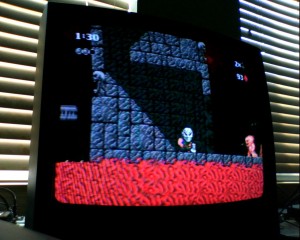
![IMG_6510[1]](https://mathpirate.net/log/wp-content/uploads/2010/11/IMG_65101-300x225.jpg)

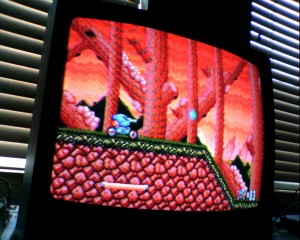



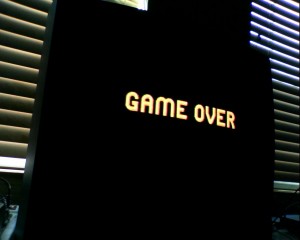
![IMG_6508[1]](https://mathpirate.net/log/wp-content/uploads/2010/11/IMG_65081-300x225.jpg)

